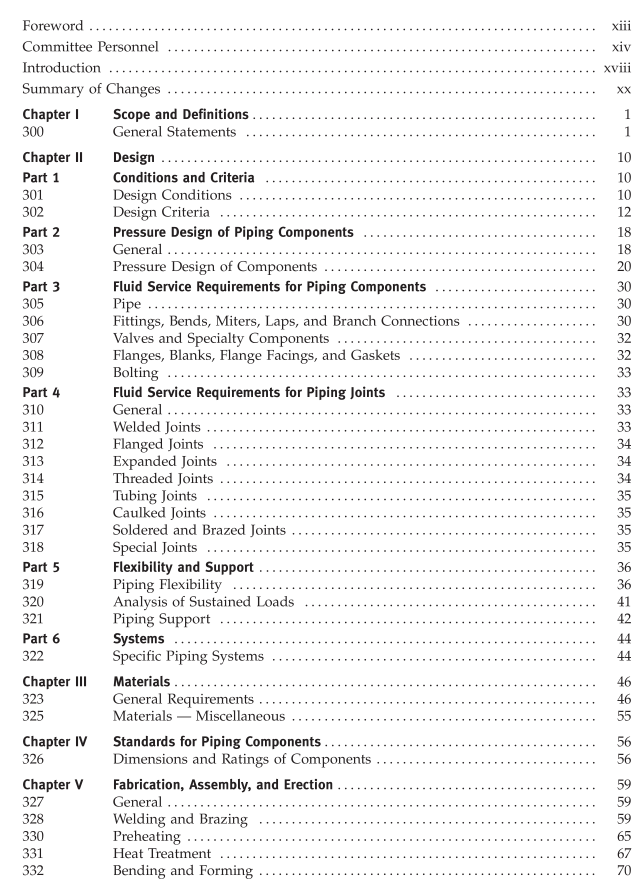ASME B31.3 pdf download

ASME B31.3 pdf download Process Piping ASME Code for Pressure Piping, B31
300 GENERAL STATEMENTS
(a) Identification.
This Process Piping Code is a Sectionofthe AmericanSociety ofMechanical Engineers Code for Pressure Piping, ASME B31, an American National Standard. It is published as a separate docu- ment for convenience of Code users.
(b) Responsibilities
(1) Owner. The owner of a piping installation shall have overall responsibility for compliance with this Code, and for establishing the requirements for design, construction, examination, inspection, and testing that will govern the entire fluid handling or process installa- tion of which the piping is a part. The owner is also responsible for designating piping in Category D, Category M, High Pressure, and High Purity Fluid Services, and for determining if a specific Quality System is to be employed. [See paras. 300(d)(4) through (7) and Appendix Q.]
(2) Designer. The designer is responsible to the owner for assurance that the engineering design of pip- ing complies with the requirements of this Code and with any additional requirements established by the owner.
(3) Manufacturer, Fabricator, and Erector. The manu- facturer, fabricator, and erector of piping are responsible for providing materials, components, and workmanship in compliance with the requirements of this Code and of the engineering design. (4) Owner’s Inspector. The owner’s Inspector (see para. 340) is responsible to the owner for ensuring that the requirements of this Code for inspection, examina- tion, and testing are met. If a Quality System is specified by the owner to be employed, the owner’s Inspector is responsible for verifying that it is implemented.
(c) Intent of the Code
(1) It is the intent of this Code to set forth engineering requirements deemed necessary for safe design and construction of piping installations.
(2) This Code is not intended to apply to the operation, examination, inspection, testing, maintenance, or repair of piping that has been placed in service. The provisions of this Code may optionally be applied for those purposes, although other considerations may also be necessary.
(3) Engineering requirements of this Code, while considered necessary and adequate for safe design, gen- erally employ a simplified approach to the subject. A designer capable of applying a more rigorous analysis shall have the latitude to do so; however, the approach must be documented in the engineering design and its validity accepted by the owner. The approach used shall provide details of design, construction, examination, inspection, and testing for the design conditions of para. 301, with calculations consistent with the design criteria of this Code.
(4) Piping elements should, insofar as practicable, conform to the specifications and standards listed in this Code. Piping elements neither specifically approved nor specifically prohibited by this Code may be used provided theyare qualified foruse as setforthinapplica- ble Chapters of this Code.
(5) The engineering design shall specify any unusual requirements for a particular service. Where service requirements necessitate measures beyond those required by this Code, such measures shall be specified by the engineering design. Where so specified, the Code requires that they be accomplished.
(6) Compatibility of materials with the service and hazards from instability of contained fluids are not within the scope of this Code. See para. F323.
(d) Determining Code Requirements
(1) Code requirements for design and construction includefluid service requirements,whichaffectselection and application of materials, components, and joints. Fluid service requirements include prohibitions, limita- tions, and conditions, such as temperature limits or a requirement for safeguarding (see Appendix G). Code requirements for a piping system are the most restrictive of those that apply to any of its elements.
(2) For metallic piping notdesignated by the owner as Category M, High Pressure, or High Purity Fluid Service (see para. 300.2 and Appendix M), Code require- ments are found in Chapters I through VI (the base Code) and fluid service requirements are found in









